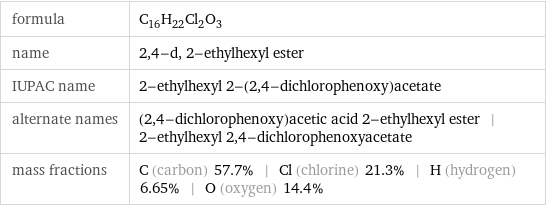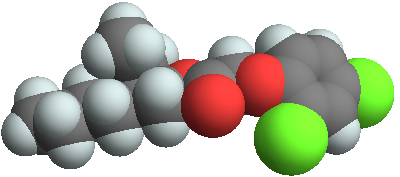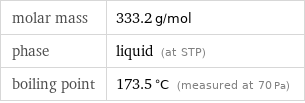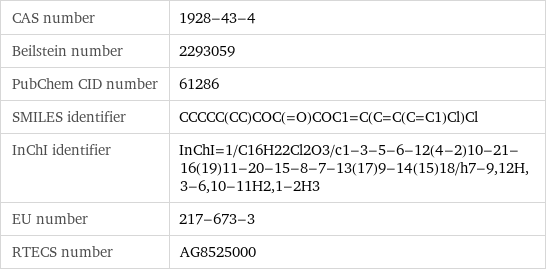Input interpretation

2, 4-d, 2-ethylhexyl ester
Chemical names and formulas

formula | C_16H_22Cl_2O_3 name | 2, 4-d, 2-ethylhexyl ester IUPAC name | 2-ethylhexyl 2-(2, 4-dichlorophenoxy)acetate alternate names | (2, 4-dichlorophenoxy)acetic acid 2-ethylhexyl ester | 2-ethylhexyl 2, 4-dichlorophenoxyacetate mass fractions | C (carbon) 57.7% | Cl (chlorine) 21.3% | H (hydrogen) 6.65% | O (oxygen) 14.4%
Lewis structure

Draw the Lewis structure of 2, 4-d, 2-ethylhexyl ester. Start by drawing the overall structure of the molecule, ignoring potential double and triple bonds: Count the total valence electrons of the carbon (n_C, val = 4), chlorine (n_Cl, val = 7), hydrogen (n_H, val = 1), and oxygen (n_O, val = 6) atoms: 16 n_C, val + 2 n_Cl, val + 22 n_H, val + 3 n_O, val = 118 Calculate the number of electrons needed to completely fill the valence shells for carbon (n_C, full = 8), chlorine (n_Cl, full = 8), hydrogen (n_H, full = 2), and oxygen (n_O, full = 8): 16 n_C, full + 2 n_Cl, full + 22 n_H, full + 3 n_O, full = 212 Subtracting these two numbers shows that 212 - 118 = 94 bonding electrons are needed. Each bond has two electrons, so in addition to the 43 bonds already present in the diagram add 4 bonds. To minimize formal charge oxygen wants 2 bonds and carbon wants 4 bonds. Identify the atoms that want additional bonds and the number of electrons remaining on each atom: Fill in the 4 bonds by pairing electrons between adjacent highlighted atoms. Note that the six atom ring is aromatic, so that the single and double bonds may be rearranged: Answer: | |
3D structure

3D structure
Basic properties

molar mass | 333.2 g/mol phase | liquid (at STP) boiling point | 173.5 °C (measured at 70 Pa)
Units

Chemical identifiers

CAS number | 1928-43-4 Beilstein number | 2293059 PubChem CID number | 61286 SMILES identifier | CCCCC(CC)COC(=O)COC1=C(C=C(C=C1)Cl)Cl InChI identifier | InChI=1/C16H22Cl2O3/c1-3-5-6-12(4-2)10-21-16(19)11-20-15-8-7-13(17)9-14(15)18/h7-9, 12H, 3-6, 10-11H2, 1-2H3 EU number | 217-673-3 RTECS number | AG8525000
Toxicity properties

RTECS classes | agricultural chemical and pesticide